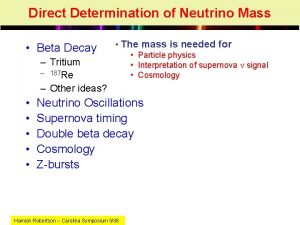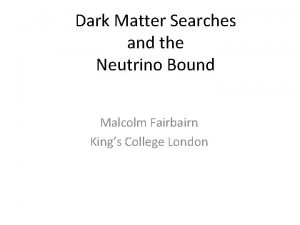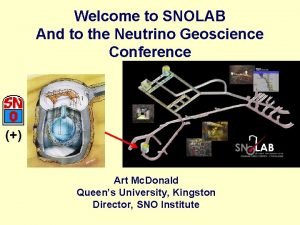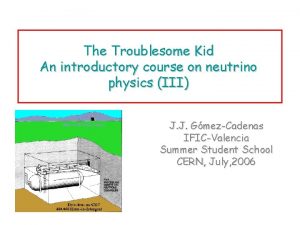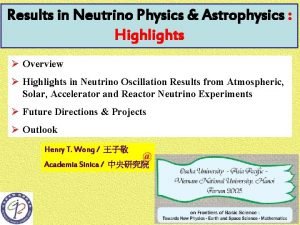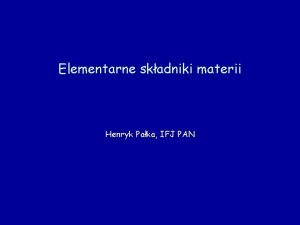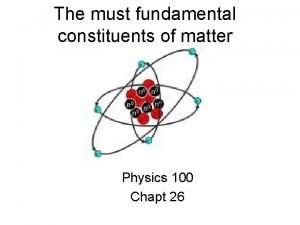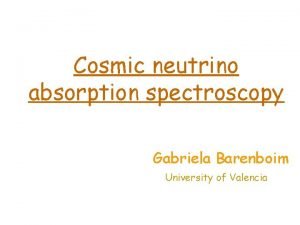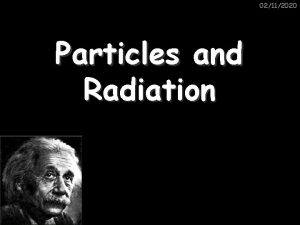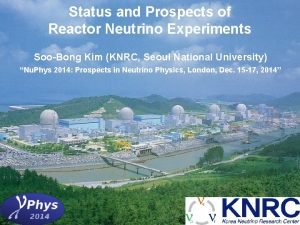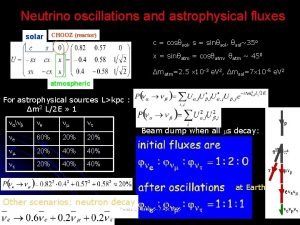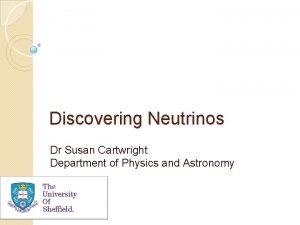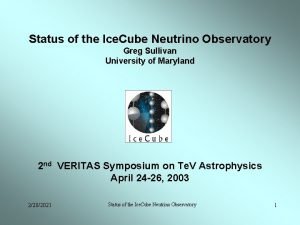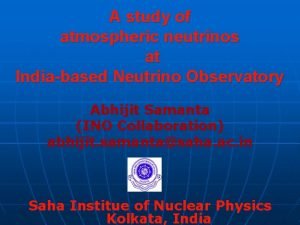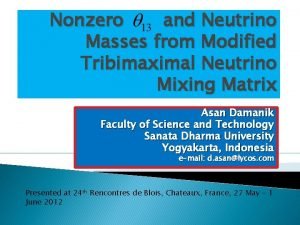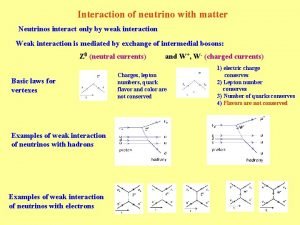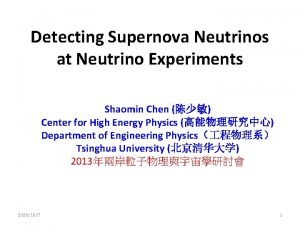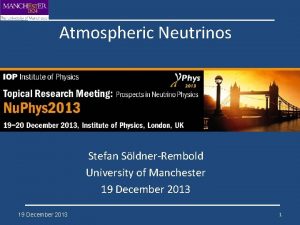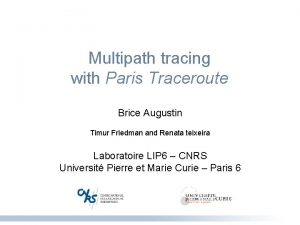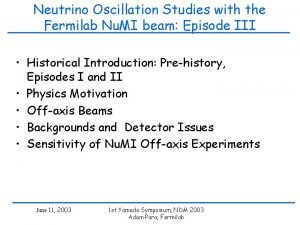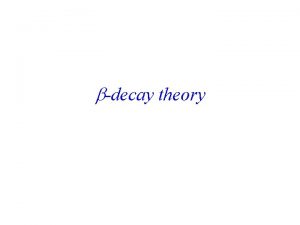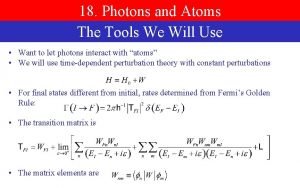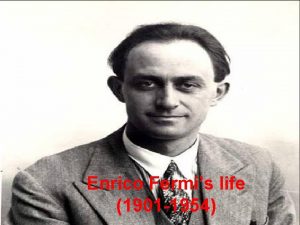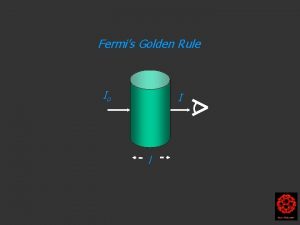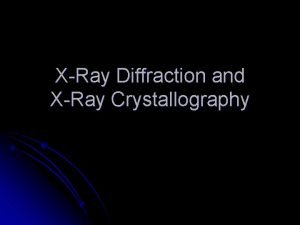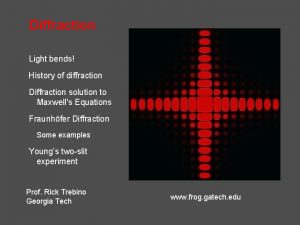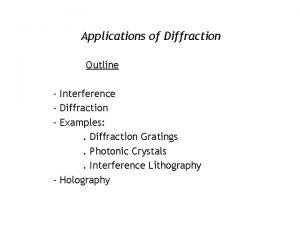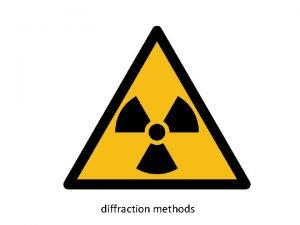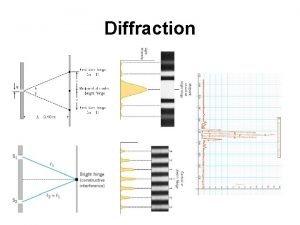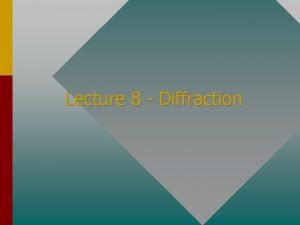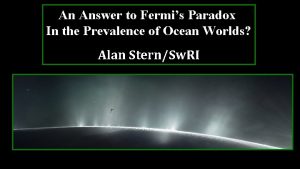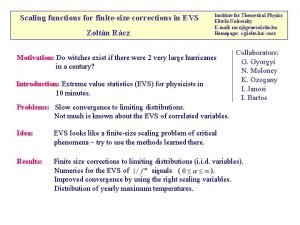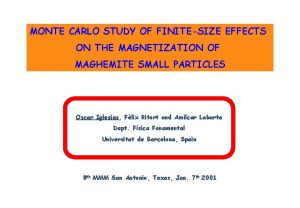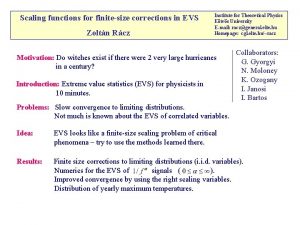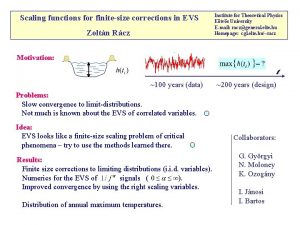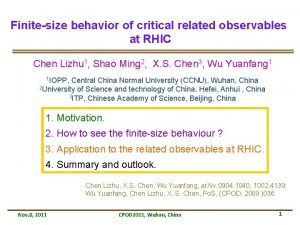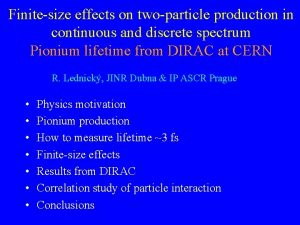Neutrino diffraction finitesize correction to Fermis golden rule









![Transition in a finite time-interval • S[T] ; S matrix for a finite time Transition in a finite time-interval • S[T] ; S matrix for a finite time](https://slidetodoc.com/presentation_image_h2/997c27dda602b30c9a1e99b89523f193/image-10.jpg)















![L_{decay-detector} = 170[m], axis = 2. 5 degree, Detector 3[m]x 3[m] ~ 10% excess L_{decay-detector} = 170[m], axis = 2. 5 degree, Detector 3[m]x 3[m] ~ 10% excess](https://slidetodoc.com/presentation_image_h2/997c27dda602b30c9a1e99b89523f193/image-26.jpg)







- Slides: 33

Neutrino diffraction : finite-size correction to Fermi’s golden rule k. ishikawa, Hokkaido University with m. sentoku, and y. tobita • Is neutrino interference (diffraction) observable? (1) Neutrino is a quantum mechanical wave and interacts with matter extremely weakly. (2) Neutrino should show a phenomenon of interference or diffraction, in a double slit-like experiment. (3)However, it is very hard to control the neutrino , from the above (1). Hence a new method must be considered. (4)Our answer and proposal ” Neutrino diffraction is observable. Use a pion (and other particle) decay process !” 1

Contents of this talk • References K. Ishikawa and Y. Tobita ar. Xiv: 1206. 2593, 1109. 3105, 1109. 4968 , others [hep-ph], prog. theo. phy. (2009) K. I and Yabuki, progress of theo. physics(2002), K. I and T. Shimomura, progress of theo. physics(2005) 1. 2. 3. 4. 5. Introduction Fermi’s golden rule : finite-size correction Probability to detect a neutrino in pion decay Light-cone singularity and neutrino diffraction Implications 2

I. Single electron interference (Tonomura) Number of events N_a<N_b<N_c<N_d interference pattern becomes clear and visible in d We study single neutrino interference 3

Unknown facts on neutrinos • Absolute neutrino mass Tritium decay electron spectrum - less double Beta decay Cosmology gives bound. Unclear now ! 4

Scattering , interference, and diffraction of neutrino ( our works) 1.Neutrino is a quantum mechanical wave , so its distribution reveals single quantum interference. 2.Neutrino is identified from physical reactions with a nucleon in nucleus. 3. 1 and 2 are combined to the probability to detect the neutrino at a finite distance. This supplies ordinary results at the infinite distance and a new physical quantity from the finite-size correction. 4.Diffraction is a main part of the finite-size correction and is observed easily with a large number of events. 5

Real pion decays experiment which? Particle decay (traditional ? ) Distance L=c. T Decay product of wave is measured in wave packet 6

2. Fermi’s Golden rule 2 -1. Transition rate at a large T is: Dirac(1927), Fermi Golden rule (1949), 2 -1. T is large but finite. Compute a finite-T correction to above Eq. (3). Correction diverges 7

1/T correction diverged. For a correct calculation : • To compute transition probability at a finite T, boundary condition should be taken into account. • For a rigorous treatment of scatterings , out-going (in-coming) state is expressed by a wave packet that is localized in space and time. (LSZ, 55) • Compute the finite-size (time) correction with the transition amplitude defined by wave packets. Then a unique value is obtained. 8

What is the finite-size effect ? 1.Quantum mechanical transition in a finite time interval T. 2.Violates the energy conservation 3.States at ultra-violet energy region, J , gives a universal correction and is important in relativistic invariant system. Compute a finite-size correction of the probability to detect the neutrino !! 9
![Transition in a finite timeinterval ST S matrix for a finite time Transition in a finite time-interval • S[T] ; S matrix for a finite time](https://slidetodoc.com/presentation_image_h2/997c27dda602b30c9a1e99b89523f193/image-10.jpg)
Transition in a finite time-interval • S[T] ; S matrix for a finite time interval T. Finite-size correction 10

Wave packets dynamics K. I and T. shimomura(prog. theor. phys: 2005) • Complete set Wave packet moves with this velocity. And a slow phase 11

3. Neutrino diffraction(ishikawa and tobita) decay amplitude Neutrino’s momentum and position are measured Plane waves Wave packet Integration over x and t = interaction region is in a moving frame 12

Wave packet effects 1. Approximate conservation of the energy in the moving frame. (Pseudo-Doppler shift) 2. Large T correction emerges for light particles, because there are many states of 13

4. Rigorous calculation : Express the probability with a correlation function decay amplitude Probability is expressed with a correlation function Correlation function (Only If energy-momentum is conserved) 1. Correlation function has a light-cone singularity which is generated by a superposition of relativistic waves. 2. The light-cone singularity is real and long-range and gives the finite-size correction. Since the energy conservation is violated, this has anomalous properties. 3. Wave packet ensures asymptotic boundary condition (LSZ) and leads new effects 14.

Correlation function • Integration variable is change to • Integral region is separated in two parts Finite size correction (energy non-conserving) Normal term

I_1: Extract the light-cone singularity About To extract light-cone singularity expanding in convergence condition: Green’s function Light-cone singularity

Integration over space-time coordinates I_1: Long-range term I_2 short range term

Probability at a finite distance • Probability is composed of the normal term and a T-dependent diffraction term, which gives a finite-size correction. 18

Diffraction term + normal term (muon neutrino) P_diffraction P/T Length(M) 19

For three flavors standard Kayser, -, -, -Akhmedov, et al, Smirnov, -- New term 20

5.Diffraction term in a muon neutrino P/T P_diffraction P_normal Length(M) 21

nu_mu-nucleon total cross section Experiments. : NOMAD & MINOS theory: normal+diffraction 22

Electron mode: helicity suppression The normal term in the electron mode is suppressed by the angular momentum and energy-momentum conservation. (Steinberger, Rudermann-Finkelstein, Sasaki-Oneda. Ozaki, ) Since the finite-size correction does not conserve the energy, it violates the helicity suppression. • When the neutrino is detected, the electron mode is enhanced. 23

Diffraction Events(enhances electron neutrino) Diffraction neutrino oscillation Exp. ( l. SND, TWN) Normal calculation(helicity suppression) Distance[M] 24

Diffraction prediction of the electron neutrino diffraction(T 2 K、on axis) 25
![Ldecaydetector 170m axis 2 5 degree Detector 3mx 3m 10 excess L_{decay-detector} = 170[m], axis = 2. 5 degree, Detector 3[m]x 3[m] ~ 10% excess](https://slidetodoc.com/presentation_image_h2/997c27dda602b30c9a1e99b89523f193/image-26.jpg)
L_{decay-detector} = 170[m], axis = 2. 5 degree, Detector 3[m]x 3[m] ~ 10% excess (maximum) 26

Neutrino from decay of pion at rest Pb Fe O Probability C 50 100 150 赤は通常の保存則での計算値(~ 30 Me. V)です

Anomalous properties of the diffraction 1 neutrino diffraction is easily observed once the statistics becomes large. Single quantum interference 2 energy conservation is violated : finite-size effect 3 lepton number appears to be non-conserved. P(L) decreases with L , so unitarity appears to be violated. But they are not. : finite-size effect and retarded effect. 4 pion life time varies due to the measurement, quantum Zeno effect. However the majority of the pion are unchanged because the neutrino interacts with matter so weakly. 28

Comparisons with previous experiments • Diffraction effect has been observed but that has not been recognized. So, unusual events have been regarded as anomalous events. They are explained with the neutrino diffraction. • High energy neutrino nucleon scattering cross section decreases with the energy slowly. This is understood by the diffraction effect of the neutrino process. • High precision experiment may provide the neutrino absolute mass. 29

The neutrino diffraction is a finite-size correction • Why does the neutrino diffraction emerge? 1. Transition in a finite time interval T, , violates the energy conservation. 2. States at ultra-violet energy region give a universal correction. 3. Relativistic invariance >> large momentum states 30

Other channels on the neutrino processes • 1. muon decay • 2. neutron decay • 3. nucleus decays • 4. neutrino scattering (In progress) 31

New phenomena caused by finite-size effects 1.Emission of light particles. Energy non-conserving transition lead background noises that has universal properties. “theory of universal noises “ 2.Interference and diffraction. interference of a new scale that is very different from wave length “physics of a new scale ” 3.Energy shift : “pseudo-Doppler shift ” 32

6.conclusion • Finite-size correction to the probability to detect the neutrino is large. • With enough number of neutrino events, the neutrino diffraction, which is the main part of the finite-size correction, is easy to observe and may provide the absolute neutrino mass. 33
 The sacrament of the last supper golden ratio
The sacrament of the last supper golden ratio Golden ratio and golden rectangle
Golden ratio and golden rectangle Neutrino mass
Neutrino mass Neutrino
Neutrino Solar neutrino
Solar neutrino The leptons
The leptons Neutrino
Neutrino Neutrino mass
Neutrino mass Lekka cząstka elementarna mion elektron lub neutrino
Lekka cząstka elementarna mion elektron lub neutrino Neutrino symbol
Neutrino symbol Neutrino density
Neutrino density Lepton number
Lepton number Neutrino
Neutrino Neutrino
Neutrino Who discovered neutrino
Who discovered neutrino Ice cube status
Ice cube status Neutrino
Neutrino Neutrino
Neutrino Solar neutrino
Solar neutrino Neutrino interaction with matter
Neutrino interaction with matter Neutrino
Neutrino Neutrino
Neutrino Dotterkärna
Dotterkärna Neutrino load balancer
Neutrino load balancer Solar neutrino
Solar neutrino Neutrino
Neutrino Advantages and disadvantages of mischief rule
Advantages and disadvantages of mischief rule Laurie bassi
Laurie bassi Fermi golden rule
Fermi golden rule Cieh level 2 award in principles of haccp
Cieh level 2 award in principles of haccp Whitely v chappel (1868)
Whitely v chappel (1868) United healthcare underwritten by golden rule
United healthcare underwritten by golden rule Golden rule in law definition
Golden rule in law definition Fermi golden rule
Fermi golden rule


